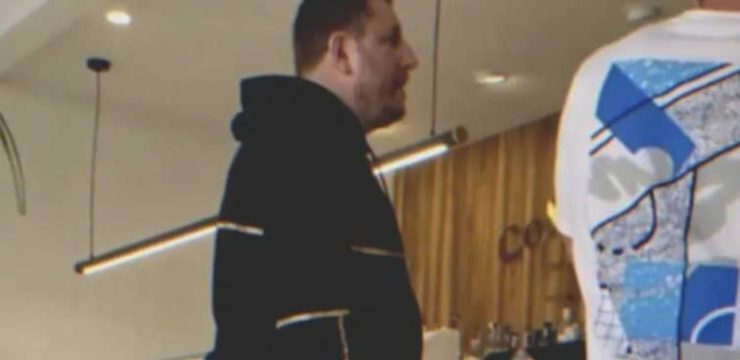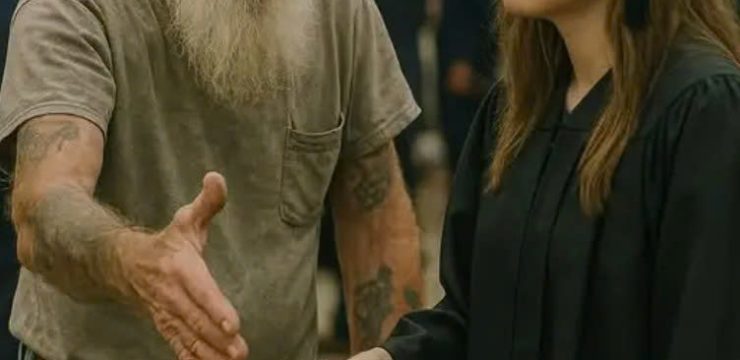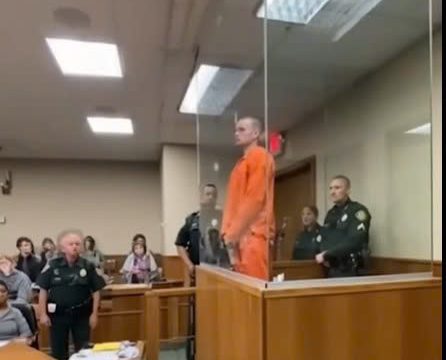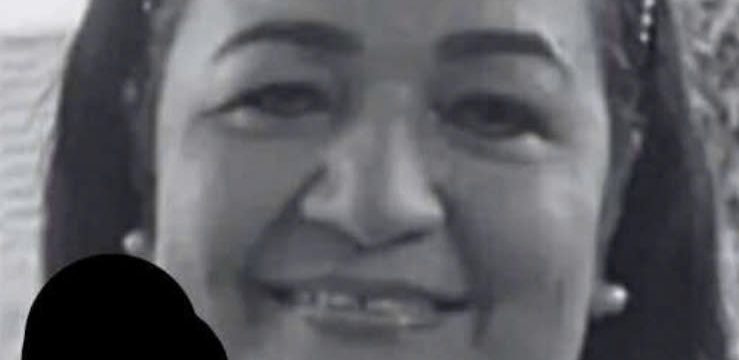What started as an ordinary evening in a quiet suburban neighborhood transformed in an instant into a scene that would soon capture national attention. A home security camera, positioned near a front porch, recorded a tense encounter that unfolded so quickly it seemed almost unreal. The recording shows a shirtless man rushing toward a police officer in what appeared to be a deliberate attempt to overwhelm him. In those few seconds, instinct and training converged, turning what could have been a tragic moment into an example of remarkable control and professionalism.

The video, which soon spread across social media platforms, captures the suspect sprinting full force toward the officer standing near the doorway of the home. Without hesitation, the officer responded with precise and measured action, intercepting the aggressor mid-charge and defusing the threat before it escalated. Witnesses nearby could be heard reacting with shock as the encounter played out so quickly that most viewers had to replay the clip to fully understand what had happened.
Online, comments poured in, with many people describing the takedown as “instant justice” and praising the officer’s ability to stay composed under pressure. Viewers pointed out that officers face unpredictable situations every day, and this was a vivid reminder of how fast things can turn dangerous. Others emphasized the importance of training, highlighting that such instinctive responses are built over years of preparation, scenario-based drills, and real-world experience. The officer’s calm reaction, even when confronted with sudden aggression, underscored the level of discipline needed in law enforcement roles.
The moment also sparked broader conversations about the responsibilities that officers carry daily. They must balance readiness with restraint and make rapid decisions that affect not only their own safety but also the safety of the community. This incident became a reminder of the complexities of modern policing—where every call can present unexpected challenges, yet officers remain dedicated to performing their duties with professionalism.
While the video of the suburban encounter spotlighted immediate danger and fast-thinking action, another story emerging across the nation reflected a different kind of courage—one rooted not in a split second, but in years of service, dedication, and passion. In Dallas, the country mourned a devastating loss after two historic World War II aircraft—the B-17 Flying Fortress and the P-63 Kingcobra—tragically collided during an air show dedicated to honoring the aviators of past generations. Six crew members lost their lives, all of whom were deeply committed to preserving America’s aviation history.
Many of these pilots were volunteers, individuals who dedicated countless hours to maintaining and flying vintage aircraft so future generations could see them in action rather than only in museums. Their work allowed audiences to connect with a pivotal time in American history, reminding people of the bravery and innovation that shaped the nation’s role in global events. After the tragedy, tributes poured in from across the country. Veterans’ groups, aviation organizations, and local communities expressed admiration for the fallen pilots, remembering them not just as skilled aviators but as historians who brought the past to life.
The Dallas air show accident served as a stark reminder that the preservation of history often comes with inherent risks. Flying decades-old aircraft requires expertise, strict maintenance, and a deep understanding of the machines’ limitations. The loss of these aviators sparked discussions about safety procedures, regulatory oversight, and the delicate balance between honoring the past and safeguarding those who keep its memory alive. Still, the legacy of the pilots endures as people continue to celebrate their passion and commitment.
Together, these two events—one dramatic and unfolding within seconds, the other representing years of dedication—illustrate how courage appears in different forms across America. The officer’s quick decision-making prevented potential harm, showing how readiness and composure can change the outcome of a dangerous moment. The aviators, on the other hand, demonstrated long-term devotion to a cause bigger than themselves, carrying forward a tradition of remembrance rooted in patriotism and education.
Both stories remind us that bravery is not defined by a single circumstance. Sometimes it is loud and sudden, emerging in a moment of crisis. Other times it is quiet and steadfast, expressed through commitment, service, and passion over time. Whether a person steps into danger to protect others or spends years preserving pieces of history for future generations, their actions deserve recognition and respect.
These moments of courage also invite reflection on the risks individuals take in service to their communities. For law enforcement officers, each day brings unpredictable challenges, yet they continue to uphold their responsibilities with dedication. For aviation historians and volunteer pilots, maintaining historical aircraft requires both skill and a willingness to face the inherent uncertainties of working with vintage machines.
From the front porch of a suburban home to the skies above Dallas, these stories highlight the vast range of bravery displayed across the country. They remind us that acts of courage can happen in a fraction of a second or be woven slowly through years of perseverance. Both forms contribute to the safety, legacy, and spirit of American communities.
As we reflect on these events, we are encouraged to recognize every expression of courage—whether it happens in the blink of an eye or through a lifetime of dedication. These stories reflect the resilience that continues to shape our nation and inspire those who witness it.





